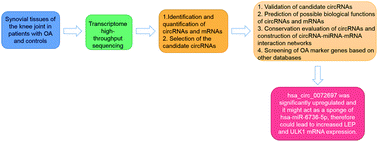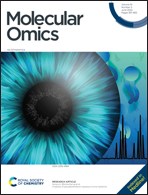Circular RNA profiles of osteoarthritic synovium†
Abstract
Purposes: To identify the circular RNA (circRNA) expression profile in the synovium of patients with osteoarthritis (OA) and explore their potential regulatory mechanism. Methods: Transcriptome high-throughput sequencing was used to detect the expression profiles of circRNA and mRNA. We performed real-time PCR for the validation of circRNAs and used bioinformatics analysis to predict their possible biological functions. The conservation of circRNAs was evaluated, a circRNA–miRNA–mRNA interaction network was constructed and the receiver operating characteristic (ROC) curves of target genes were also drawn. Results: We found 136 differentially expressed circRNAs, 64 upregulated and 72 downregulated. We also found 2035 differentially expressed mRNAs, 1216 upregulated and 819 downregulated. It was verified by qRT-PCR that hsa_circ_0072697 was significantly upregulated. The GO analysis results showed that the parental genes were mainly enriched in organelle organization, cytosol and anion binding. The most enriched pathways for these circRNAs participated in cellular senescence. And hsa_circ_0072697 might act as a sponge of hsa-miR-6736-5p, which could therefore lead to increased LEP and ULK1 mRNA expression. Conclusions: CircRNAs are significantly expressed in the knee synovium of OA patients and may play an important role in the occurrence and development of OA. The potential mechanism could be sponging miRNAs to increase mRNA expression.



 Please wait while we load your content...
Please wait while we load your content...